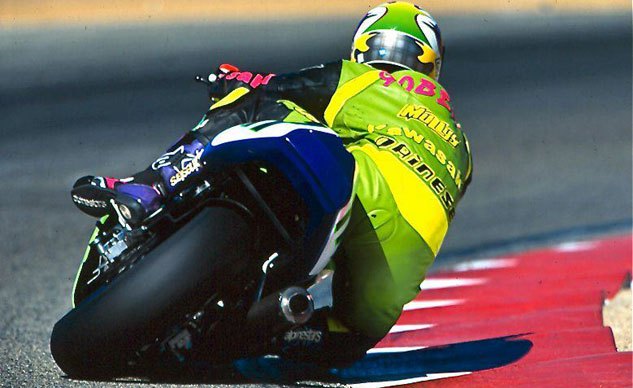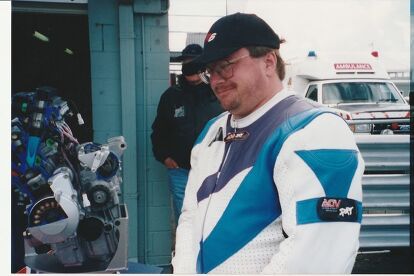Whatever! – Hey You Kids, Come Play on My Lawn!
I was excited as the next guy to hear about Wayne Rainey’s new organization, KRAVE, galloping to the rescue of American Roadracing (say, didn’t that used to be a magazine?), but it did get me reminiscing over what great times we had spectating over the years – even being able to participate a few times – and hoping Wayne and crew won’t be closing the barn door after the horses have all retired to Las Vegas or been incarcerated.
Sears Point was the first AMA National roadrace I attended, must’ve been late `80s/early `90s. What I mainly remember was sitting in the bleachers along the front straight and hearing a muffled explosion, then seeing a guy’s legs cartwheel through the sky in a cloud of dust and haybales on the back straight. That guy turned out to be Scott Gray, and in those days there were plenty more maniacs in the pits just like him. I hope I’m just an aging guy waxing nostalgic, but roadracing in those days – Superbike racing, in specific – seemed to be the logical culmination of the crazy youth phase for a lot of guys my age. Born on or around 1960, before digital entertainment, before urban sprawl, before helicopter parenting – we grew up doing stupid-dangerous things in vacant lots and parking lots without adult supervision – and there really could’ve been no more logical extension than racing motorcycles around on road circuits, with the obvious exception of racing them around Supercross tracks.
It was always the alpha male of the pack who did the thing first, and if he thought it was a reasonable thing to ride a TS185 over a railroad trestle or drive his Jeep out onto a frozen pond during the spring thaw or jump the Snake River in a rocket cycle, then who were the rest of us to question? Now that there’s peer review, in the form of the ubiquitous GoPro and YouTube, you can google up just about any given scenario in real time on your phone, see exactly how badly it’s likely to end, and decide to just say no. My generation had to learn everything the hard way.
By 1990, the year I turned 30, it was well and truly on: Vance & Hines Yamaha and Jamie James were defending champs, and here came Team Muzzy Kawasaki with Doug Chandler, later to be joined by Scott Russell and one Anthony Gobert. Those guys were good enough to actually win World Superbike races, and Russell was good enough to win the WSB Championship, in 1993. There were Fast by Ferracci Ducatis ridden by Doug Polen (1991 and `92 WSB champ) and Mat Mladin (before MM went to Yoshimura Suzuki). Miguel Duhamel was there for Honda (most years, anyway), whose free spending ways and gleaming transporters were where everybody wanted to be. Suffice to say, there was a cast of colorful characters; I only just scratch the surface. Critically, the budgets were such that, even though race reporting was never really my thing, all us magazine stiffs would take the wives and kids to Laguna Seca for the weekend anyway and expense the Turn One hospitality suite, the beachfront hotels and all the rest of it. Good times. Great times, really (though if you asked for a raise, it was clear they were giving none away).
As tobacco dollars dried up, the lion’s share of that money came from the factories, who were selling CBRs, FZRs, ZX-Rs, GSX-Rs and assorted other Rs as fast as they could come up with new acronyms (every two years or so), and we of the press were happy to fan the flames. I lived for track days, where I could hop on a bike just like the one Miguel rides (!) and lap Laguna Seca or Willow Springs or California Speedway within 15 seconds of my heroes! Okay, 20. You had to plan your track days well ahead in those days; they filled up like the Daytona 200 starting grid.
Then came the Housing Bubble, the Daytona Motorsports Group, and the winding down. Honda, the 800-pound elephant, excused itself – citing rules disagreements with DMG, but the timing was such that a cynic might have seen the thing as a convenient justification for Honda to begin cutting losses as sales of CBRs went south. Way south. Along with all its other motorcycle lines. Kawasaki left too. Ducati was already gone. BMW was barely ever here. Mladin left in a huff (conveniently also, since Josh Hayes was just starting to take his measure). Then the Speed Channel went away. Hats off to Yamaha and Yoshimura Suzuki for staying the course, and to EBR and KTM for making an effort. It makes me slightly cranky to read the chest-thumping press releases from many manufacturers who cite Record Sales, but can’t spare a dime for what was once the greatest feeder system in international racing. And the best parties of the year.
But maybe it really is Just Business. “Adventure bikes” are what all the adult kids want now – bikes that let us feel like we’re still pushing the envelope at much lower speeds. Personally, I think I’m at greater risk of bodily injury going 20 mph off-road on a 600-pound BMW than I am at 125 on smooth pavement with no rocks or trees to run into, but maybe that’s just me. I still get just as excited about track days as I ever did, but they happen with far less frequency than they used to: Reason number one is that the manufacturers just don’t build new sportbikes with nearly the frequency they once did. Checking in with an old buddy in the track day business here in SoCal reveals that I am not alone: Business is better, he says, but nowhere close to the pre-bust days.
At the end of the day, Bill Clinton said it best: It’s the economy, stupid. 180-horsepower superbikes are a lot of fun (thank God for traction control), but they do burn through fuel and tires and dollars – dollars that just aren’t as discretionary for most people as they once were. Beyond the dollars, though, I just worry that now that we boomers have passed onto the Adventure Bike stage, the kids (anybody under about 35) just aren’t as speed-crazed as my generation was. They’re smarter than we were. (Or are they? Ladies and gentlemen, I give you downhill mountain biking.) We used to accept the occasional speeding ticket as a cost of doing business. My kid shudders at the thought: It’s a fairly recent thing to expect you’ll be Tased or shot or body-cavity searched during a routine traffic stop, I suppose.
At my age (which always seems to be within a year of the Average Motorcycle Rider in the U.S.), it’s probably a good thing they don’t turn me loose quite so often on rocketship sportbikes, and it’s no doubt a good thing that those bikes are harder to obtain for new riders. Maybe Honda, sometimes so inscrutable, knows exactly what it’s doing trotting out all those CBR300Rs and 500Rs. The new KTM RC390 is genius (and EIC Duke says KTM has been talking about initiating a race class in America to accommodate it). Yamaha’s $6990 FZ-07 just won Honorable Mention as Motorcycle of the Year in our 2014 MOBOTY awards. The Ninja 300 is a great motorcycle, period. I wonder how many street versions of the Supermono Ducati could sell? And God knows what Erik Buell and his friends at Hero are working on, but I can assure you there is no rest in Mukwonago.
A good economic crack-up is in some ways a good thing; it’s an ill wind that blows no man good. Inexpensive little bikes from Japan are how this whole thing got started, way back in the `60s. Maybe a new generation of lightweight sportbikes, with Wayne Rainey and associates in the AMA roadracing saddle, will be just the thing to re-ignite the roadracing flame in the U.S. all over again. Let’s hope so. I’m pretty sure I can still take most of you punks. Here, hold my beer…
More by John Burns







































Comments
Join the conversation
Thanks for the read.
Keep waxing nostalgic. We'll all be there someday.